
Edinburgh Place Ferry Pier
Encyclopedia
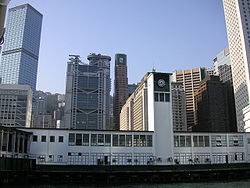
Pier
A pier is a raised structure, including bridge and building supports and walkways, over water, typically supported by widely spread piles or pillars...
in Edinburgh Place
Edinburgh Place
Edinburgh Place is a public square in Central, Hong Kong, adjacent to the Victoria Harbour. The Hong Kong City Hall is located in the square. In addition, the Edinburgh Place Ferry Pier and Queen's Pier were also located in the square before they were demolished in early 2007.-History:The...
, Central, Hong Kong
Central, Hong Kong
Central is the central business district of Hong Kong. It is located in Central and Western District, on the north shore of Hong Kong Island, across Victoria Harbour from Tsim Sha Tsui, the southernmost point of Kowloon Peninsula...
; the pier, with its clock tower, was a prominent waterfront landmark. The pier, built in 1957 at the height of the Modern Movement, was located near the City Hall
City Hall, Hong Kong
The Hong Kong City Hall is a building located at Edinburgh Place, Central, Hong Kong Island, Hong Kong.Since Hong Kong does not designate itself or any part of itself as a city, there is no mayor or city council; therefore, the City Hall does not hold the offices of a city government, unlike most...
and the General Post Office
General Post Office, Hong Kong
General Post Office is the headquarters of Hongkong Post. Built in 1976, it is located at Connaught Place, Central, Hong Kong. The office is adjacent to former Star Ferry Pier, Jardine House and International Finance Centre...
.
The pier was the central flashpoint of the Hong Kong riots in 1966
Hong Kong 1966 riots
The Hong Kong 1966 Riots was a series of disturbances that took place over three nights on the streets of Kowloon, Hong Kong in the spring of 1966...
, and 40 years later became the focus of a confrontation between conservationists and the government, which wanted to demolish the pier to allow for reclamation.
The ferry from the pier was suspended on 11 November 2006, its function being replaced by piers 7 and 8 of Central Ferry Piers about 300 metres away from the former site (as the crow flies
As the crow flies
"As the crow flies" or beelining is an idiom for the shortest route between two points; the geodesic distance.An example is the great-circle distance between Key West and Pensacola, at either end of the U.S...
), further into Victoria Harbour
Victoria Harbour
Victoria Harbour is a natural landform harbour situated between Hong Kong Island and the Kowloon Peninsula in Hong Kong. The harbour's deep, sheltered waters and strategic location on the South China Sea were instrumental in Hong Kong's establishment as a British colony and its subsequent...
. Demolition commenced on 12 December, and was completed in early 2007.
History
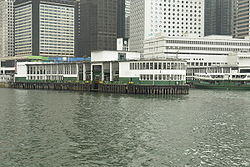
Land reclamation
Land reclamation, usually known as reclamation, is the process to create new land from sea or riverbeds. The land reclaimed is known as reclamation ground or landfill.- Habitation :...
. The shoreline was shifted from its position at the time, level to the Mandarin Hotel
Mandarin Oriental, Hong Kong
Mandarin Oriental, Hong Kong is a five-star hotel, located on Connaught Road in Central, Hong Kong, owned and managed by Mandarin Oriental Hotel Group. The hotel opened its doors in 1963 as “The Mandarin”, and quickly drew recognition for its service and elegance...
. The pier was built in 1957 in Edinburgh Place
Edinburgh Place
Edinburgh Place is a public square in Central, Hong Kong, adjacent to the Victoria Harbour. The Hong Kong City Hall is located in the square. In addition, the Edinburgh Place Ferry Pier and Queen's Pier were also located in the square before they were demolished in early 2007.-History:The...
, at the height of the Modern Movement, near the City Hall
City Hall, Hong Kong
The Hong Kong City Hall is a building located at Edinburgh Place, Central, Hong Kong Island, Hong Kong.Since Hong Kong does not designate itself or any part of itself as a city, there is no mayor or city council; therefore, the City Hall does not hold the offices of a city government, unlike most...
complex which was being planned at the time.
The Star Ferry Pier was designed by a local Chinese architect, Hung Yip Chan (born in 1921). He worked in the Architectural Office (AO) of the Hong Kong Government from 1952 to 1957 as an assistant architect. He designed the elegant façade of the pier, and the Chief Architect, Michael Wright, added the Clock Tower to make the pier more balanced and practical.
The chimes of the turret clock installed at the pier marked every quarter-hour since the pier's inauguration in 1957. The clock was a gift from John Keswick, who had in turn received it from the Prince of Belgium. The mechanism was manufactured by British company Edward John Dent
Edward John Dent
Edward John Dent was a famous English watchmaker noted for his highly accurate clocks and marine chronometers.He founded the Dent company.- Early years :...
, which also provided the mechanical signature to "Big Ben
Clock Tower, Palace of Westminster
Big Ben is the nickname for the great bell of the clock at the north end of the Palace of Westminster in London, and is generally extended to refer to the clock or the clock tower as well. It is the largest four-faced chiming clock and the third-tallest free-standing clock tower in the world...
" of London.
There is a major bus terminus on the Kowloon side, which is conveniently situated close to the ferry. Thousands of residents passed through this principal gateway to Hong Kong Island from the Kowloon Peninsula
Kowloon Peninsula
The Kowloon Peninsula is a peninsula that forms the southern part of the main landmass in the territory of Hong Kong. The Kowloon Peninsula and the area of New Kowloon are collectively known as Kowloon....
daily from 1957 until 2006. However, the inauguration of the Cross Harbour Tunnel in 1972 popularised vehicular travel across the harbour and reduced the flow of passengers. From 1972 to 2006, the ferry was still used by many as the shortest route from Tsim Sha Tsui
Tsim Sha Tsui
Tsim Sha Tsui , often abbreviated as TST, is an urbanized area in southern Kowloon, Hong Kong. The area is administratively part of the Yau Tsim Mong District. Tsim Sha Tsui East is a piece of land reclaimed from the Hung Hom Bay now east of Tsim Sha Tsui...
(TST) to Central District, and a daily average of 74,000 passenger trips were made across the harbour in 2004.
On the island side, various routes of the NWFB, Citybus
Citybus (Hong Kong)
Citybus Limited is one of the three major bus operators in Hong Kong. It provides both franchised and non-franchised bus service. The franchised route network serves mainly Hong Kong Island, cross-harbour routes , Ocean Park, North Lantau and Hong Kong International Airport...
, and public light bus
Public light bus
A Public light bus is a common public mode of transport in Hong Kong. It mainly serves the area that standard Hong Kong bus lines cannot reach as efficiently. It is also colloquially known as a minibus or a van, defined as a kind of share taxi....
es connect to many destinations on Hong Kong Island
Hong Kong Island
Hong Kong Island is an island in the southern part of the Hong Kong Special Administrative Region. It has a population of 1,289,500 and its population density is 16,390/km², as of 2008...
.
Relocation
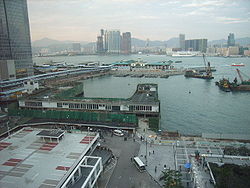
Queen's Pier
Queen's Pier, named after Queen Victoria, was a public pier in front of City Hall in Edinburgh Place, Central, Hong Kong. For three generations it served not only as a public pier in day-to-day use but also as a major ceremonial arrival and departure point...
would be demolished and 16 hectares of land directly in front of the fourth- generation pier reclaimed to make way for a six-lane road and a low-rise shopping centre. The cost was estimated at HK$3.5 billion. The Government said that the historical significance of the third-generation pier would be recognised and promised to recreate the landmark on the new waterfront.
In 2001, an impact assessment for the Central reclamation recommended the relocation of the Star Ferry, and this was approved by the Antiquities Advisory Board
Antiquities Advisory Board
The Antiquities Advisory Board is a statutory body of the Government of Hong Kong created in 1976 to evaluate old buildings in Hong Kong, and to recommend those with historical or architectural merit for listing as monuments. It is under the responsibility of the Home Affairs Bureau, directly...
in 2002.
Demolition
3D Laser Scanning3D scanner
A 3D scanner is a device that analyzes a real-world object or environment to collect data on its shape and possibly its appearance . The collected data can then be used to construct digital, three dimensional models....
Technology in digital recording of structures was applied to capture three-dimensional images of the pier before the demolition.
Following the pier's decommissioning on 12 November 2006, demolition work started amidst protests. The demolition was originally scheduled for the early part of 2007, but demolition was brought forward by 3 months, to 12 December 2006. The government ignored a nonbinding motion in September in the Legislative Council of Hong Kong
Legislative Council of Hong Kong
The Legislative Council is the unicameral legislature of Hong Kong.-History:The Legislative Council of Hong Kong was set up in 1843 as a colonial legislature under British rule...
urging it to retain the pier and clock tower.
The demolition crew took control of the site by erecting scaffolding on 6 December 2006, and demolition commenced on 12 December. Workers took down the clock mechanism and clock face, leaving a gaping hole, and then proceeded to lift the clock tower off in one piece. After the protesters had been dispersed, the remainder of the pier was completely dismantled, away from the glare of publicity.
Controversy
.jpg)
Consultants who prepared the Environmental Impact Assessment report in 2001 for the Central reclamation noted the pier's significant role in Hong Kong's transport history. The Government was warned that a public backlash could be expected when the full implications of the reclamation were known.
However, the Government had maintained that the Pier and its tower was not old enough to be classified as "historical" and that people were not necessarily "concerned about the building itself". To some extent, it was not wrong, since the activists were mainly fighting for the preservation of a public place and against the methods and urban planning policies of its government, perceived to favour business interests over the public interest. The struggle to preserve the Star Ferry and, later, the Queen's Pier, was the occasion to raise questions on Hong Kong's history, the question of colonialism, and that of democracy in the HKSAR.
The Government had grossly underestimated the very strong public sentiment about this 49-year-old landmark in the "collective memory
Collective memory
Collective memory refers to the shared pool of information held in the memories of two or more members of a group, and was coined by the philosopher and sociologist Maurice Halbwachs. Collective memory can be shared, passed on and constructed by groups both small and large...
" of Hong Kong residents. By its own retrospective admission, it lacked legitimacy: a Government spokesman conceded that the it had failed to gain the moral high ground.
Loss of convenience
Ferry passengers would face a lengthier trek to reach the new pier. By relocating the new piers 300 m away, it is estimated that the Star FerryStar Ferry
The Star Ferry, or The "Star" Ferry Company, is a passenger ferry service operator in Hong Kong. Its principal routes carry passengers across Victoria Harbour, between Hong Kong Island and Kowloon...
could lose perhaps 13 percent or more of passengers due to its inconvenience. On the Tsim Sha Tsui side of the harbour, the proposed relocation of the bus terminus which acts as a feeder for the ferry is forecast to further reduce passenger numbers by one-fifth.
This loss, totalling one-third of its passengers, would translate into revenue loss of some HK$17 million per annum for Star Ferry.
Architectural importance
Architects and conservationists argued that the pier was architecturally significant to Hong Kong as one of the last remaining examples of a Streamline ModerneStreamline Moderne
Streamline Moderne, sometimes referred to by either name alone or as Art Moderne, was a late type of the Art Deco design style which emerged during the 1930s...
public building (along with the Central Market
Central Market
Central Market was a fresh food market in Central, Hong Kong. Located between Jubilee Street, Queen Victoria Street, Queen's Road Central and Des Voeux Road Central, it was the first wet market in Hong Kong. By its side is the first public female toilet and first above-ground toilets in Hong Kong...
and Wan Chai Market
Wan Chai Market
The Wan Chai Market was constructed in 1937. It is located at 264 Queen's Road East and Stone Nullah Lane in Wan Chai, Hong Kong Island. It is a Grade III Historic Building....
which have been earmarked for demolition); culturally the pier was widely recognised as a part of local collective memory. The Hong Kong Institute of Architects warned against the destruction of Hong Kong's heritage, saying it would be an irreversible mistake. Public opinion has resulted in alternatives put forward to preserve the clock tower, including moving the proposed six-lane road or relocating the clock tower to the front of the new pier as a memorial.
State of the clock
One reason cited by the Government against the relocation of the turret clock and tower was that an expert feasibility study advised that there was "no guarantee the clock and chimes would continue to work after relocation, due to their age and obsolete components". However, Neil Brennon Wright of Thwaites & ReedThwaites & Reed
Thwaites & Reed has been in continuous manufacture since its foundation and claims to be the oldest clock manufacturing company in the world. Geoffrey Buggins MBE, the last of the original family clockmakers saw drawings of Thwaites clocks dating back to 1610...
, the world's longest operating clockmaking firm, who arrived from England on 18 December 2006 to examine the clock, said that his firm had restored far worse.
The Government promised that it would "rebuild" the chimes of the clock, complete with the restitution of the original clock faces and mechanism at some nearby location.
Public sentiment

Antiquities and Monuments Office
Antiquities and Monuments Office was established when the Antiquities and Monuments Ordinance was enacted in 1976, to preserve Hong Kong's monuments under appropriate protection....
, was to become reality. With the imminent threat of demolition, the local community rallied to save pier, to widespread media coverage. In the weeks running up to the cessation of service from the pier, thousands of Hong Kong residents arrived to post banners and other messages in support of retention.
There were some 150,000 nostalgic visitors to the Pier and harbour crossing on the night of 11 November 2006. To mark the special occasion, Star Ferry hosted a "last ride" before the pier was closed-down, with the last four ferries leaving this pier on the stroke of midnight. Eighteen hundred Hongkongers willingly paid up $88 (40 times the normal fare) for the last ride, whose proceeds were designated for charity.
Protest movement
On 19 November 2006, the Civic Party, Democratic Party, Harbour-front Enhancement Committee, Hong Kong Institute of Architects, People's Sustainable Development Committee, Clear the Air, and Earth Care jointly met to urge the public to fight for the preservation of the pier. Over 1,000 signatures were collected on that one day alone, in a petition to be submitted to Chief Executive Donald TsangDonald Tsang
Sir Donald Tsang Yam-kuen, GBM, KBE is the current Chief Executive and President of the Executive Council of the Government of Hong Kong....
and other senior officials. In addition, a group of protesters began a peaceful sit-in that day. So Sau Chung, veteran campaigner (now a monk), whose hunger strike against Star Ferry fare increases triggered the riots in 1966, came by to lend his support.
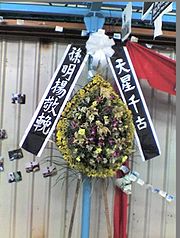
Leung Kwok-hung
Leung Kwok-hung , also known as Long Hair , is a member of the Legislative Council of Hong Kong , a founding member of the League of Social Democrats and a democratic political activist.-Biography:Leung is a self-proclaimed Trotskyist and a member of April Fifth Action, a radical socialist...
, rushed into and occupied part of the demolition site, chanting slogans from the roof of an excavator and demanded to meet Secretary for Housing, Planning and Lands
Secretary for Housing, Planning and Lands
The Hong Kong Secretary for Housing, Planning and Lands was the head of the Housing, Planning and Lands Bureau, which was responsible for urban planning policy, public housing and the management and selling of public lands...
, Michael Suen Ming-yeung.
In addition to the public, Civic Party
Civic Party
Civic Party is a liberal democratic political party in Hong Kong.The Civic Party is currently the third largest political party in the Legislative Council of Hong Kong, with five members securing seats in the 2008 Hong Kong Legislative Council elections...
legislators, and Choy So-yuk, a councillor from the pro-government Democratic Alliance for the Betterment of Hong Kong
Democratic Alliance for the Betterment of Hong Kong
Democratic Alliance for the Betterment and Progress of Hong Kong , formerly known as Democratic Alliance for the Betterment of Hong Kong, is the largest pro-Beijing political party in Hong Kong...
, showed up to lend support.
The demolition drew widespread condemnation from the public, legislators, and conservationists, all of whom claimed the government action was contrary to the wishes of the public. Legco members tabled motions to immediately halt the demolition, pending further consultation. The Government denied a last-minute reprieve, reiterating that there has been "adequate consultation", and forged ahead with demolition. The Conservancy Association claimed it made its objection known in 1996 when Government proposed to construct a temporary road through the Edinburgh Place and that the Government has never consulted the public regarding demolition of the pier, or the adjacent Queen's Pier.
After the demolition of the pier, the government said that it would consider the memories of the citizens and not the historic value of the building/structure before demolishing it.
Conservationists vowed to take the fight to Queen's Pier, and a number of other historical sites threatened with a similar fate. At the end of 2006, in a testament to how the protests have struck a chord with the public, the Ferry protesters were voted "Person of the Year" by RTHK Radio 3
Radio Television Hong Kong
Radio Television Hong Kong is a public broadcasting organisation in Hong Kong that is operated as an independent department in the government under the Broadcasting Authority. RTHK operates seven radio channels, and produces television programmes that are then broadcast through local television...
. Local Action, the group of rather young cultural and media activists which formed the core of the movement, were to later influence social movements, in Hong Kong as well as in the mainland: part of the more militant "post 80s" generation, they are critical of government business collusion, a one-sided development approach, Hong Kong's subordinate status within China and the perceived lack of democracy in the territory, and have been involved in the fight for real political reform in Hong Kong
Democratic development in Hong Kong
Democratic development in Hong Kong has been a major topic since the transfer of sovereignty to China in 1997. The One country, two systems principle allows the Hong Kong government to administer all areas of government except foreign relations and defense separately from the national Chinese...
, and against the Express Rail link to Guangzhou
Opposition to the Guangzhou-Hong Kong Express Rail Link
Opposition to the Guangzhou-Hong Kong Express Rail Link , is a movement and period of civil discontent in Hong Kong between mid 2009 and early 2010...
.
Demonstration timeline
- August 2006, a group of local artists subsequently known as "We Are Society" and patronised by Para/Site member Kith Tsang Tak-ping started carrying out shows and setting up installations on the premises of the Star Ferry Pier in an attempt to heighten people's awareness.http://www.eurozine.com/articles/2007-10-29-tsui-en.html
- 19 November 2006, pressure groups met at pier to collect petition signatures; protesters began sit-in at the pier.
- 6 December 2006, demolition workers broke through a human chain of peaceful protesters and erected scaffolding around the site.
- 12 December 2006, site occupied by demonstrators determined to stop demolition.
- 13 December 2006, demolition resumed after all demonstrators were forcibly removed from the site by police, despite protesters remaining outside.
- 14 December 2006, 200 people attended a candlelight vigil to mark the pier's 49th anniversary; activists again broke through a police cordon to retake the building. 13 protesters were detained in the early hours of the morning
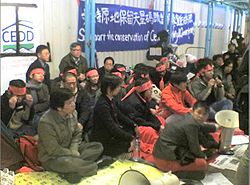
- 15 December 2006, Government vows to get tough against protesters and accelerates demolition by carrying on work overnight; the clock tower is lifted off in one piece and taken off-site. A group of 20 students start a 49 hour sit-inSit-inA sit-in or sit-down is a form of protest that involves occupying seats or sitting down on the floor of an establishment.-Process:In a sit-in, protesters remain until they are evicted, usually by force, or arrested, or until their requests have been met...
hunger strikeHunger strikeA hunger strike is a method of non-violent resistance or pressure in which participants fast as an act of political protest, or to provoke feelings of guilt in others, usually with the objective to achieve a specific goal, such as a policy change. Most hunger strikers will take liquids but not...
at midnight, one hour to represent each year of the pier's existence. - 17 December 2006, 200 people marched on the Government Headquarters demanding to see the Chief Executive; violent scuffles broke out; Conservationists vow to take the fight to Queen's PierQueen's PierQueen's Pier, named after Queen Victoria, was a public pier in front of City Hall in Edinburgh Place, Central, Hong Kong. For three generations it served not only as a public pier in day-to-day use but also as a major ceremonial arrival and departure point...
. - 18 December 2006, legislators incensed at a volte-faceVolte-faceVolte-face is a total change of position, as in policy or opinion; an about-face.The expression comes through French, from Italian voltafaccia and Portuguese volte face, composed of volta and faccia ....
by the demolition company who recanted on selling the remains to conservationists and by suggestion that the clock tower may be used as landfill, demanded to know the whereabouts of the remains. - 19 December 2006, newspapers published interviews of witnesses who claim to have seen the old clock tower being broken up at the building waste landfill in Tuen Mun.
- 11 May 2007, harbour protester Ho Loy convicted of criminal damage for having slashed the canvas surrounding the demolition works on 12 December 2006 and ordered to pay $800 in compensation.
See also
- Heritage conservation in Hong KongHeritage conservation in Hong KongThis article details the history and status of Heritage conservation in Hong Kong, as well as the role of various stakeholders.An indication of the size of the built heritage in Hong Kong is given by a territory-wide survey conducted by the Antiquities and Monuments Office between 1996 and 2000,...
- Central Police StationCentral Police StationCentral Police Station is a former police station, located at the eastern end of Hollywood Road, in Central, Hong Kong. It is awaiting development following its decommissioning.-History:...
- Yau Ma Tei Police StationYau Ma Tei Police StationYau Ma Tei Police Station is a police station in Yau Ma Tei, Kowloon, Hong Kong. Its buildings at No. 627 Canton Road, at the junction of Public Square Street, were erected in 1922 after relocation from the junction of Public Square Street and Shanghai Street.-History:Yau Ma Tei Police Station...
- Lee Tung StreetLee Tung StreetLee Tung Street , known as the Wedding Card Street by the locals, is located at Wan Chai, Hong Kong. Involved in a project executed by the Urban Renewal Authority , was torn down in December 2007...

